Aphasia is a language disorder that affects your ability to communicate, often resulting from brain injury or stroke. It can impact speaking, understanding, reading, and writing, making everyday interactions challenging. Explore the rest of the article to learn about symptoms, types, and effective treatment options for aphasia.
Table of Comparison
| Aspect | Aphasia | Bradyphrenia |
|---|---|---|
| Definition | Language impairment affecting speech, comprehension, reading, or writing | Slowed mental processing speed causing delayed thinking and responses |
| Primary Cause | Brain damage, often from stroke or traumatic injury | Neurological disorders such as Parkinson's disease or dementia |
| Symptoms | Difficulty speaking, naming objects, understanding language | Slowed cognition, reduced mental alertness, delayed reaction time |
| Diagnosis | Neurological exam, speech-language assessment, brain imaging | Neuropsychological testing, clinical evaluation, imaging for underlying causes |
| Treatment | Speech therapy, cognitive rehabilitation, addressing underlying cause | Medications for underlying condition, cognitive therapy, supportive care |
| Prognosis | Varies by cause and severity; potential for improvement with therapy | Progressive in nature; management focuses on slowing progression |
Introduction to Aphasia and Bradyphrenia
Aphasia is a language disorder resulting from brain damage that impairs speech production, comprehension, reading, or writing, commonly caused by stroke or traumatic brain injury. Bradyphrenia refers to the slowing of mental processes, often observed in neurodegenerative diseases like Parkinson's disease, characterized by delayed cognitive responses and reduced mental agility. Distinguishing aphasia's linguistic deficits from bradyphrenia's cognitive slowing is crucial for accurate diagnosis and targeted treatment in neurological care.
Defining Aphasia: Symptoms and Causes
Aphasia is a language disorder characterized by impaired speaking, understanding, reading, or writing due to brain damage, frequently caused by stroke, traumatic brain injury, or neurodegenerative diseases. Symptoms of aphasia range from difficulty finding words (anomia) and forming sentences (agrammatism) to complete inability to communicate verbally or comprehend language. Unlike bradyphrenia, which involves generalized cognitive slowing, aphasia specifically affects language processing centers in the brain such as Broca's and Wernicke's areas.
Understanding Bradyphrenia: Key Features
Bradyphrenia is characterized by slowed cognitive processing, impacting attention, memory, and executive functions, distinct from aphasia which primarily affects language abilities. Key features of bradyphrenia include delayed thinking, reduced mental alertness, and difficulty in problem-solving tasks, often observed in neurodegenerative diseases such as Parkinson's and Alzheimer's. Understanding bradyphrenia involves recognizing its influence on cognitive speed rather than speech production or comprehension deficits typical of aphasia.
Neurological Mechanisms Behind Aphasia
Aphasia results from damage to the language centers of the brain, primarily the left hemisphere's Broca's and Wernicke's areas, disrupting language comprehension and production by impairing neural pathways involved in speech processing. Bradyphrenia, characterized by slowed cognitive processing, is linked to dysfunctions in subcortical structures such as the basal ganglia and frontal lobes, affecting overall information processing speed rather than language-specific circuits. The distinct neurological substrates in aphasia reflect targeted cortical damage, whereas bradyphrenia involves more diffuse neural slowing mechanisms.
What Causes Bradyphrenia?
Bradyphrenia is primarily caused by neurological conditions such as Parkinson's disease, brain injuries, and certain types of dementia that affect cognitive processing speed. Unlike aphasia, which specifically impacts language abilities due to damage in language-related brain areas, bradyphrenia results from slowed mental function linked to broader brain dysfunction. Neurodegenerative diseases and metabolic disturbances can also contribute to the development of bradyphrenia by impairing neuronal communication and cognitive efficiency.
Aphasia vs Bradyphrenia: Core Differences
Aphasia is a language disorder affecting speech production, comprehension, reading, and writing, typically caused by brain injury in regions like Broca's or Wernicke's areas. Bradyphrenia refers to the slowness of thought processes and cognitive function, often observed in neurodegenerative diseases such as Parkinson's disease. The core difference lies in aphasia primarily impairing communication abilities, whereas bradyphrenia results in overall cognitive slowing without specific language deficits.
Diagnostic Approaches for Both Conditions
Diagnostic approaches for aphasia primarily involve comprehensive language assessments conducted by speech-language pathologists, utilizing tools such as the Boston Diagnostic Aphasia Examination and the Western Aphasia Battery to evaluate speech production, comprehension, repetition, and naming abilities. Bradyphrenia diagnosis relies on neuropsychological testing aimed at assessing cognitive processing speed and executive functions, with instruments like the Trail Making Test and Digit Symbol Substitution Test often applied to detect slowed mental activity. Neuroimaging techniques, including MRI and PET scans, support differential diagnosis by revealing localized brain damage patterns typical in aphasia or global cerebral dysfunction associated with bradyphrenia.
Impact on Communication and Daily Functioning
Aphasia primarily disrupts language abilities, causing difficulties in speaking, understanding, reading, or writing, which directly impairs effective communication and engagement in daily conversations. Bradyphrenia slows cognitive processing speed, leading to delayed responses and challenges in organizing thoughts, which can affect both communication clarity and the timely completion of routine tasks. Both conditions significantly hinder social interactions and independence, but aphasia mainly impacts language output, while bradyphrenia influences overall mental processing and response time.
Treatment and Rehabilitation Strategies
Treatment for aphasia primarily involves speech and language therapy tailored to the individual's specific language deficits, often incorporating techniques such as constraint-induced language therapy and melodic intonation therapy to improve communication skills. Bradyphrenia rehabilitation focuses on cognitive training programs aimed at enhancing processing speed, attention, and executive functions, frequently combined with occupational therapy to support daily activities and improve mental agility. Both conditions benefit from multidisciplinary approaches, including neuropsychological support, caregiver education, and the use of assistive technologies to maximize functional recovery and quality of life.
Prognosis and Long-term Outcomes
Aphasia prognosis varies depending on the severity and cause, with some patients achieving significant language recovery through speech therapy, while others may experience persistent communication deficits. Bradyphrenia, characterized by slowed cognitive processing often seen in neurodegenerative conditions such as Parkinson's disease, generally has a progressive course with limited improvement and an emphasis on managing symptoms. Long-term outcomes in aphasia can include improved quality of life with targeted rehabilitation, whereas bradyphrenia typically leads to gradual functional decline requiring comprehensive supportive care.
Aphasia Infographic

 libterm.com
libterm.com